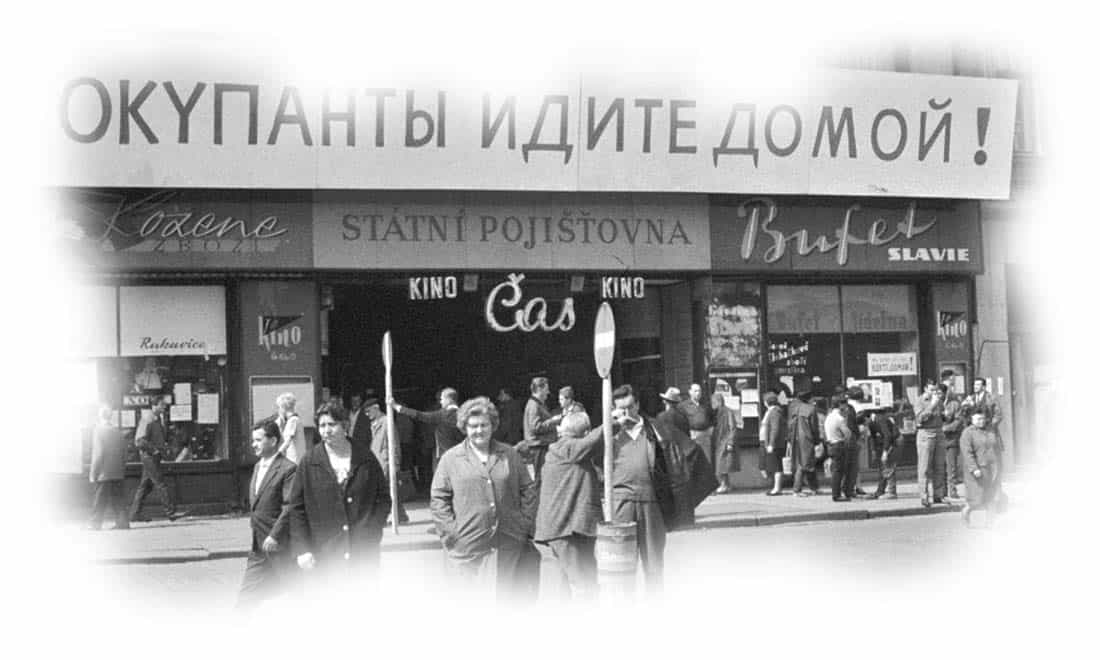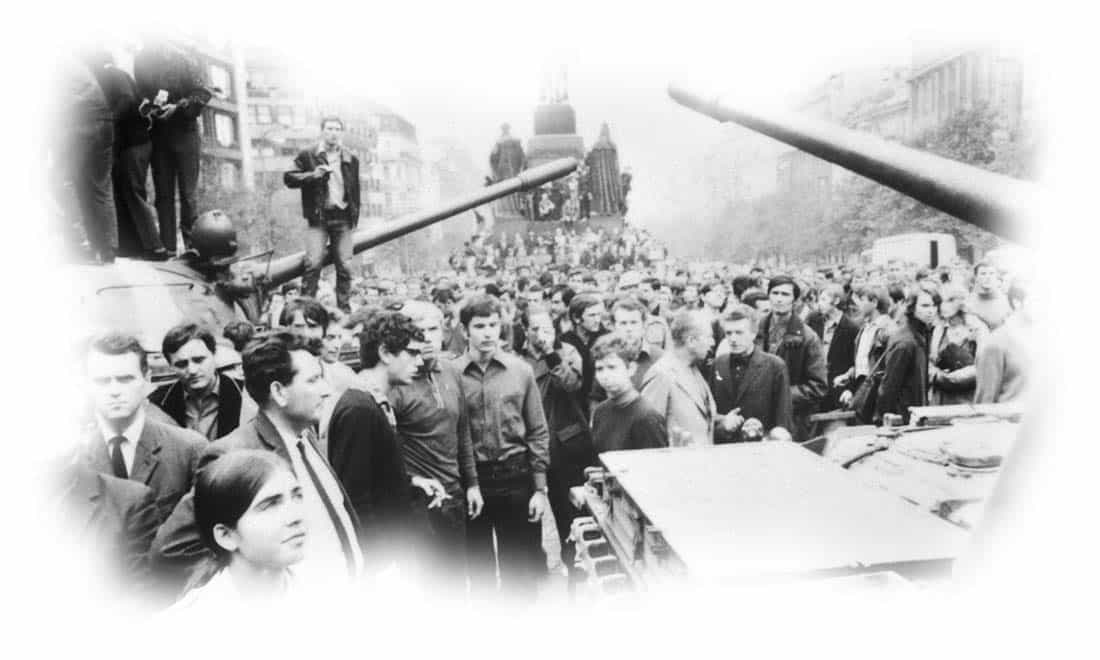On the night of August 20-21, 1968, about 250,000 troops and other personnel from the U.S.S.R., Poland, Hungary, East Germany, and Bulgaria crossed into Czechoslovakia from the north, east, and south. With this operation the Soviet Union stopped the process of democratic reforms, known as the Prague Spring, which had spread throughout Czechoslovakia.
As the invasion came as a surprise, many people spontaneously began hanging up anti-Soviet posters and Czechoslovak flags, or spoke to the troops to try and persuade them that there was no reason for a military operation.
When the Soviet-led troops arrived at the Czechoslovak Radio headquarters in Prague to stop the broadcasts and take over the station, the situation escalated as locals built barricades, determined to defend not only the building, but an important symbol of Czechoslovakia's statehood.
The invasion of Czechoslovakia was followed by a process of "normalization" that saw the restoration of the authoritarian Communist rule that existed before the Prague Spring reforms.
In the end, 137 Czechoslovaks died and more than 500 were seriously wounded during the invasion by the Warsaw Pact troops.
Here are the stories of four women who didn't hesitate to act bravely during these tumultuous days of August 1968.
Tap/click a person to play and pause their introduction. Click their name to jump to their story.
Full story
Full story
Full story
Full story
We ran into a building to get the wounded people outside. The rear wall was damaged from the shots, glass fell into the courtyard...
Stanislava Draha was helping wounded people as a volunteer.
When Stanislava Draha woke up on August 21, 1968, on the first day of her vacation, she turned on the radio and heard a report about a fire and shooting near the state radio headquarters in central Prague. When she looked outside the window and heard tanks going by, she realized it was a live broadcast.
Fearing that residents might get hurt, Draha dressed quickly and ran to Czechoslovak Radio on Vinohradska Street. There she saw wounded and disoriented people running out of a building damaged by bullets and tank fire. Along with some passersby, she ran into the building as glass and plaster fell around them.
On the staircase near the second floor, Draha met an elderly man who had a broken nose and was bleeding profusely. She decided to help him get to the Vinohradska hospital, which was a distant 3.5 kilometers from the radio building. As they approached the Orionka tram station they saw an officer from the invading Warsaw Pact. Noticing that the man was hurt and covered in blood, the officer offered to drive them to the hospital. Draha described the officer as a very decent man.
Draha spent the rest of that day on the streets of Prague treating wounded people, helping them get home, and taking photos to document what was happening around her.
She says the Warsaw Pact invasion of her country had a major impact on her life and caused her to worry about the future of Czechoslovakia.

The banner 'Occupiers Go Home!' in Russian in Plzen, Czechoslovakia. (CTK)
I experienced the Soviet-led troops shooting recklessly into the Czechoslovak Radio's building, into windows.
Vera Homolova was a radio reporter broadcasting from a covert studio.
On August 21, 1968, Vera Homolova received a phone call around 4 a.m. and was told that Warsaw Pact troops had invaded Czechoslovakia. Working as a journalist for Czechoslovak Radio, she knew she had to quickly get to the newsroom. So she dressed and ran to the radio headquarters, arriving shortly before troops came to carry out a command to stop the broadcasts.
The situation at the radio building on Vinohradska Street escalated around 7 a.m., when more tanks came and hundreds of people gathered and built barricades to protect the radio.
After the troops burst into the newsroom, Homolova sneaked out the back door and left the building. At first, she ran to the army studio located nearby, then was sent by the supervisor to the Tesla company building in Strasnice, where a provisional studio was established. Homolova and her two colleagues started receiving messages by phone and immediately broadcasted the most up-to-date information on what was happening. To avoid detection, the journalists lived and worked at the studio until September 9, 1968, when broadcasting resumed from Czechoslovak Radio's headquarters.
Homolova described the 1968 events as a milestone in her life. She was later fired from Czechoslovak Radio and the only job she could get for several years was as a cleaning lady.

Soviet tanks surrounded by crowds of Czechs protesting at Wenceslas Square in Prague against the invasion. (CTK)
We climbed the ladder to take down a street sign when suddenly we heard a terrible rumble…it was an armored vehicle arriving.
Vera Roubalova was a student who reacted to the occupation by painting posters and taking down street signs.
Vera Roubalova was at her parents' house when she woke up in the middle of the night to discover Czechoslovakia was being invaded by Warsaw Pact armies.
Although she heard a Czechoslovak Radio announcement advising people to stay calm and wait for the response from the Czechoslovak government, she quickly got in touch with her friends who were politically active. Together they decided to make the orientation in Prague more difficult for the Soviet-led troops by taking down the street signs. Roubalova says it felt like an adventure until a tank that was passing by -- and later started shooting -- made them realize the situation was very serious.
Later, Roubalova and a friend were painting posters that were distributed across the city. She remembers a strong feeling of unity and solidarity as everyone was doing his or her best by bringing paper, painting supplies, or food to the basement where they were hiding. With these posters, that for example read "Go home, Ivan", Roubalova and her friends were determined to persuade the troops that the invasion was a mistake.
Roubalova wasn't persecuted for her activity during the invasion, but she admits she has never stopped feeling tension towards the countries that occupied Czechoslovakia.

A young Czech couple look at Soviet tanks on their way to the Czechoslovak radio headquarters in Prague on August 21, 1968. (CTK)
My colleague knocked me down and laid on top of me to save me from being hit by gunfire.
Marta Bystrovova was a newspaper reporter writing about the Soviet-led invasion from its epicenter.
When Marta Bystrovova arrived at the Svobodne Slovo newsroom on August 21, 1968, Wenceslas Square was packed with people, tanks, and other armored vehicles. Along with two colleagues she decided to write a report about what they saw. Bystrovova says Warsaw Pact troops didn't have a clue where they had ended up and why the local citizens didn't appreciate their "brotherly" help. She also admits that locals were encouraging the troops to oppose their commanders.
While Bystrovova and her colleagues were standing [in front of] the National Museum, watching what was happening on Wenceslas Square, the Soviet-led troops started shooting towards the museum -- which they seemingly mistook for the Czechoslovak Radio building. Bystrovova's colleague knocked her down and saved her from being hit by gunfire. After that the journalists went to the radio building for a while and then ran back to the newsroom to write the first special edition of the newspaper. After they finished, they immediately started working on a second special edition.
Due to the strategic location of the newsroom, the troops occupied the offices of the newspaper the next day and started using it as their headquarters. Afterwards, Svobodne Slovo journalists met at various people's apartments or at train stations to submit their articles. They also helped distribute the newspaper to readers and delivered them to embassies -- especially Western ones.
When the "normalization" process started, Bystrovova was on maternity leave and because of that she wasn't fired. But she discovered upon returning to the newsroom that journalists were no longer allowed to report freely.